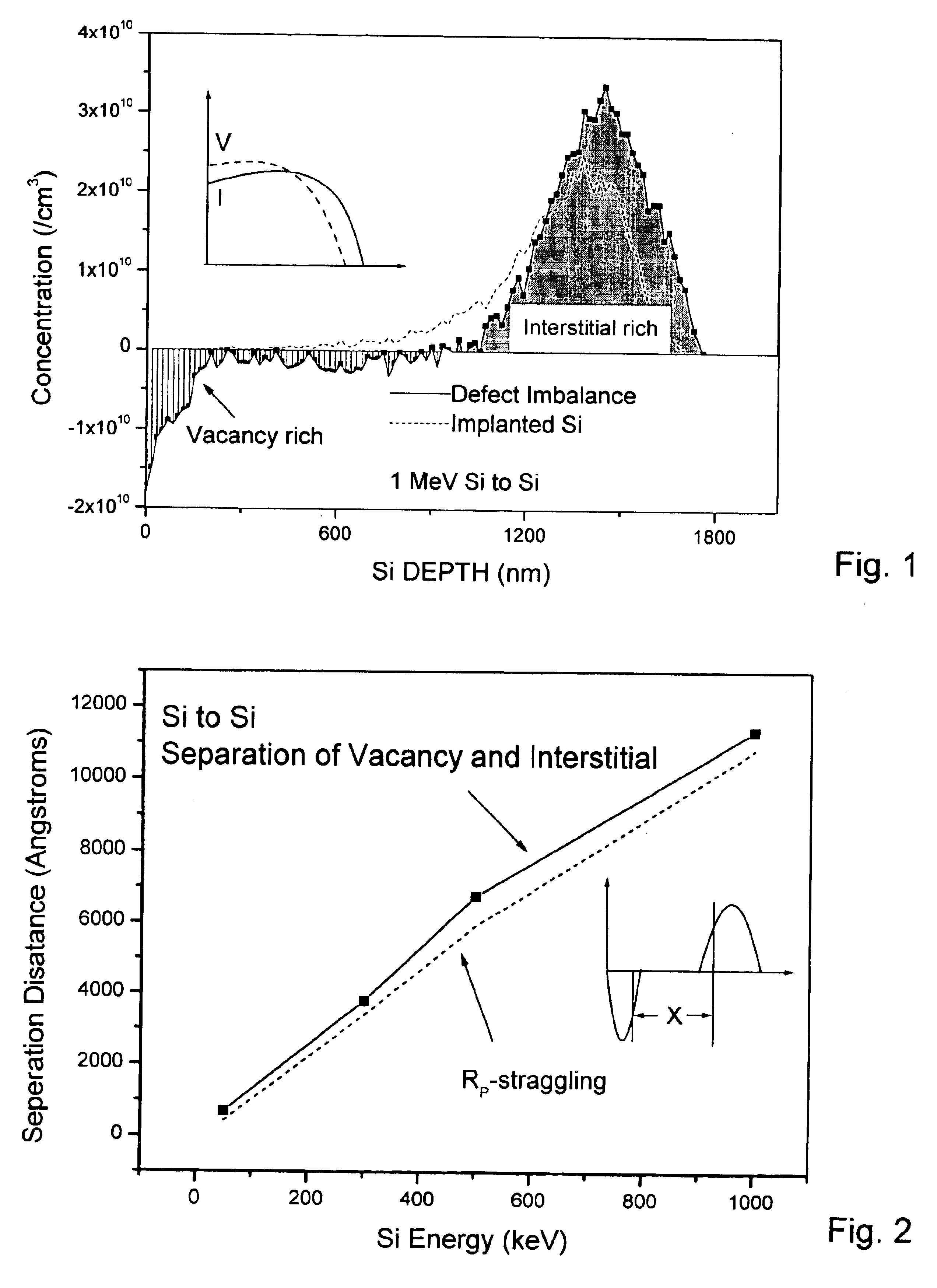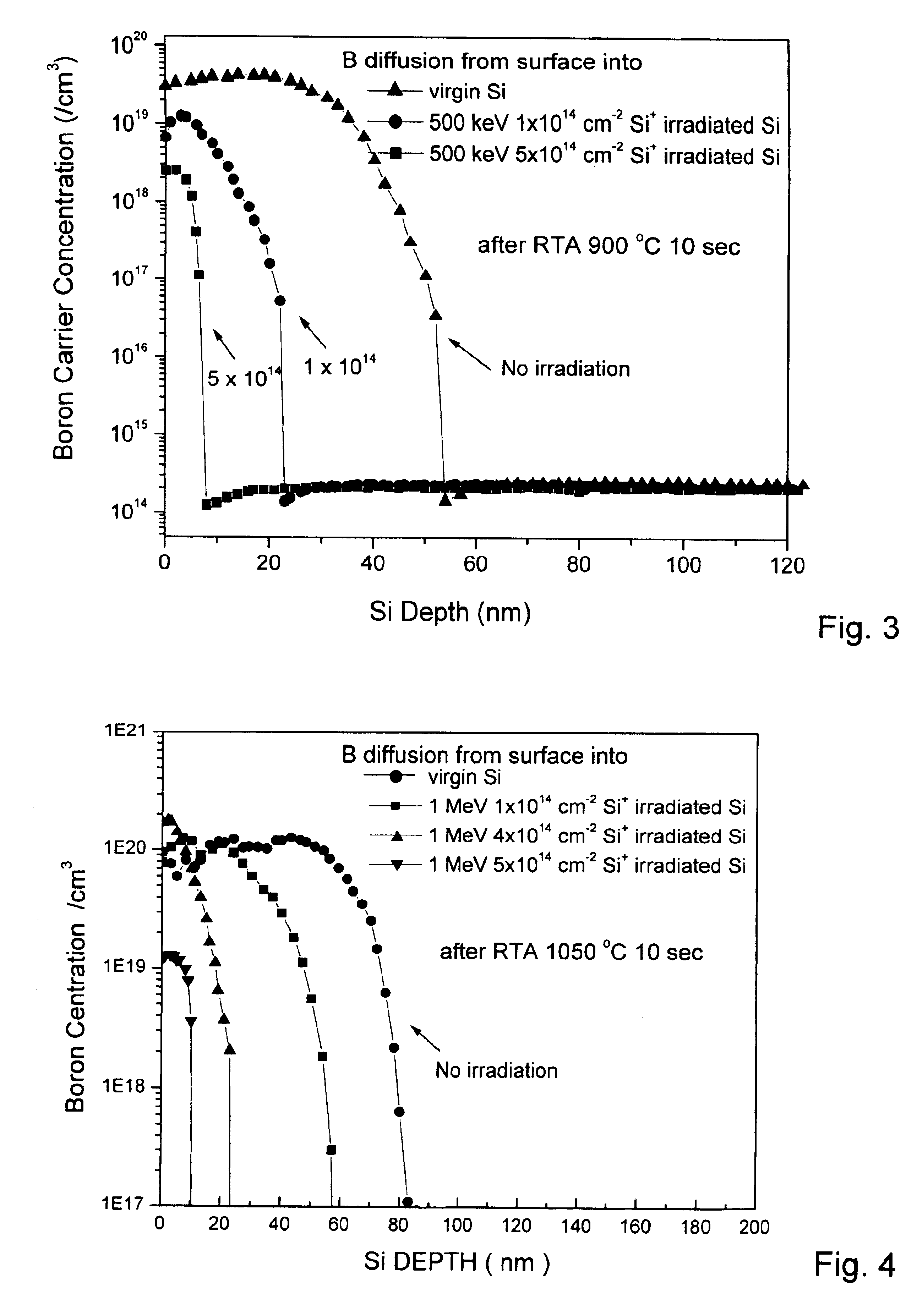Semiconductor wafer with ultra thin doping level formed by defect engineering
a technology of defect engineering and semiconductors, applied in the direction of semiconductor devices, electrical equipment, basic electric elements, etc., can solve the problems of inability to solve, the current of the implanter is significantly reduced, and the output is not high, and achieves high levels of vacancies
- Summary
- Abstract
- Description
- Claims
- Application Information
AI Technical Summary
Benefits of technology
Problems solved by technology
Method used
Image
Examples
example 1
n-type (100) Czochralski-grown Si wafers were first implanted with 500 keV Si ions to a dose of 1.times.10.sup.14 or 5.times.10.sup.14 / cm.sup.2, respectively, followed by an HF etch to remove the native oxide and then by deposition of a 10 nm layer of boron. A liquid nitrogen cooled substrate holder was used to hold the wafer during the boron deposition to decrease the mobility of the deposited boron atoms to avoid boron island formation. A layer about 4 nm thick was uniformly deposited. After the deposition, Si wafers were rapid thermal annealed at 900.degree. C. for 10 sec. FIG. 3. shows a graph of a typical spreading resistance profiles of samples first implanted with 500 keV Si ions to a dose of 1.times.10.sup.14 or 5.times.10.sup.14 / cm.sup.2 respectively, followed by deposition of a 10 nm layer of boron, and annealing
example 2
n-type (100) Czochralski-grown Si wafers were first implanted with 1 MeV Si ions with doses of 1.times.10.sup.14 / cm.sup.2, 4.times.10.sup.14 / cm.sup.2 and 5.times.10.sup.14 / cm.sup.2 respectively, then a thin boron layer was deposited on the cooled wafer by by e-gun deposition. Subsequent annealing was at 1050.degree. C. for 10 sec.
FIG. 4 shows a graph of typical spreading resistance profiles of boron doped silicon.
example 3
n-type (100) Czochralski-grown Si wafers were first implanted with 5.times.10.sup.14 / cm.sup.2 of Si.sup.+ ions with incident energies of 50 keV or 500 keV, and then a 10 nm thick boron layer was deposited onto the cooled surface of the Si substrate. The samples were subsequently annealed at 900.degree. C., 950.degree. C. and 1050.degree. C. for 15 sec. Using higher energy bombardment such as 500 keV to get a larger separation of vacancies and interstitials, boron diffusion was further suppressed over that of 50 keV implanted sample.
FIG. 5 shows a graph of typical secondary ion mass spectrometry (SIMS) depth profiles of boron diffused from a surface deposited layer into an high energy ion implantation damaged Si substrate.
PUM
 Login to View More
Login to View More Abstract
Description
Claims
Application Information
 Login to View More
Login to View More - R&D
- Intellectual Property
- Life Sciences
- Materials
- Tech Scout
- Unparalleled Data Quality
- Higher Quality Content
- 60% Fewer Hallucinations
Browse by: Latest US Patents, China's latest patents, Technical Efficacy Thesaurus, Application Domain, Technology Topic, Popular Technical Reports.
© 2025 PatSnap. All rights reserved.Legal|Privacy policy|Modern Slavery Act Transparency Statement|Sitemap|About US| Contact US: help@patsnap.com



